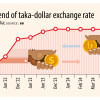What is a crawling peg?

A crawling peg is a system of exchange rate adjustments in which a currency with a fixed exchange rate is allowed to fluctuate within a band of rates.
The par value of the stated currency and the band of rates may also be adjusted frequently, particularly in times of high exchange rate volatility, according to Investopedia.
Crawling pegs are often used to control currency moves when there is a threat of devaluation due to factors such as inflation or economic instability. Coordinated buying or selling of the currency allows the par value to remain within its bracketed range.
The primary objective when a crawling peg is established is to provide a degree of stability between trading partners.
Due to high inflation rates and fragile economic conditions, the currencies of Latin American countries are commonly pegged to the US dollar. As a pegged currency weakens, both the par value and the bracketed range can be adjusted incrementally to smooth the decline and maintain a level of exchange rate predictability between trading partners.
Because the process of pegging currencies can result in artificial exchange levels, there is a threat that speculators, currency traders or markets may overwhelm the established mechanisms designed to stabilise currencies.
Maintaining a crawling peg imposes constraints on monetary policy in a manner similar to a fixed peg system, the International Monetary Fund (IMF) said.
Referred to as a broken peg, the inability of a country to defend its currency can result in a sharp devaluation from artificially high levels and dislocation in the local economy, Investopedia said.
An example of a broken peg occurred in 1997 when Thailand ran out of reserves to defend its currency. The decoupling of the Thai baht from the dollar started the Asian Contagion, which resulted in a string of devaluations in Southeast Asia and market selloffs around the globe.
Currently, only three countries -- Botswana, Honduras, and Nicaragua – use a crawling peg, according to the IMF.
In 2022, some 13.4 percent of the IMF members used hard pegs, 46.9 percent soft peg, which includes the countries using the crawling peg, and 34 percent floating exchange rates.

 For all latest news, follow The Daily Star's Google News channel.
For all latest news, follow The Daily Star's Google News channel. 








Comments